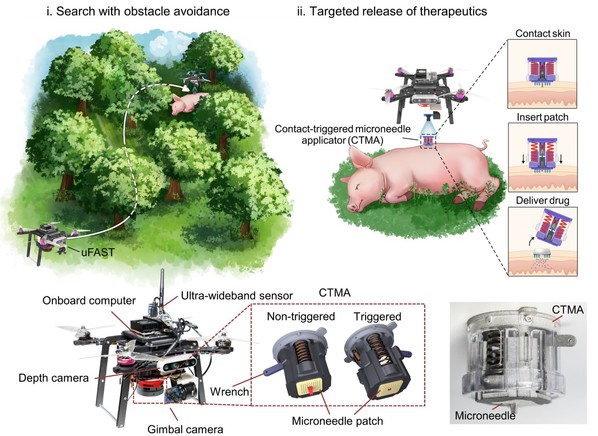For patients suffering from sudden illnesses such as myocardial infarction and severe hypoglycemia, prompt administration of emergency medications is imperative, otherwise they may be at great risk of death. Actually, a large number of deaths still occur due to untimely emergency care caused by the lack of emergency equipment and therapeutics around the patients, or the inability of the patient to call for help, or traffic congestion.
To this end, the team of Prof. GU Zhen and Prof. YU Jicheng from the College of Pharmaceutical Sciences, together with Prof. LU Haojian from the College of Control Science and Engineering at Zhejiang University, have developed a novel strategy for emergence care - an unmanned aerial vehicle (UAV)-mediated first aid system for targeted delivery (uFAST). The uFAST consists of a UAV, a contact-triggered microneedle applicator (CTMA), and an emergency therapeutics-loaded microneedle patch. Among them, the UAV can receive the first aid signals and autonomously reach to identify first aid targets; the CTMA can realize effective microneedle administration into the skin for first aid by providing uniform insertion force without additional assistance; and the microneedle patch with a dual-mode cannot only supply a basal dose of emergency medication in the first instance for patients, but also support a subsequent responsive drug release to prevent potential overdose side effects or underdose induced drug ineffectiveness. The in vivo study validated that uFAST successfully implemented autonomous first aid in an insulin-overdosing hypoglycemic diabetic minipig model, effectively preventing a sustained decrease in blood glucose levels and facilitating an increase to the normal range.

Figure 1. Schematic and physical diagram of the UAV autonomous drug delivery system for first aid.
This work has been published online Advanced Materials as Unmanned Aerial Vehicle-Mediated Drug Delivery for First Aid. The lead authors of this paper are SHENG Tao, a PhD studen and JIN Rui, a master student at Zhejiang University.






